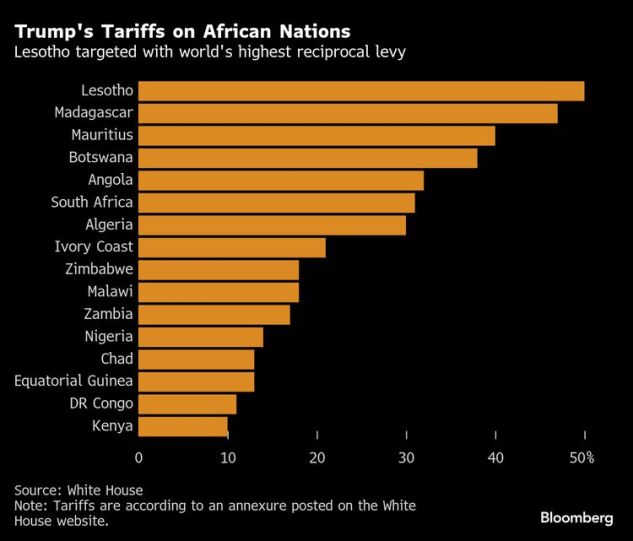
U.S TARIFFS 2.0 AND ITS POTENTIAL IMPACT ON THE SOUTH AFRICAN ECONOMY: THE ECONOMIC RISK MITIGATION STRATEGIES
U.S TARIFFS 2.0 AND ITS POTENTIAL IMPACT ON THE SOUTH AFRICAN ECONOMY: THE ECONOMIC RISK MITIGATION STRATEGIES
Highlights:
- Critical Analysis: Examines how US tariffs could disrupt South Africa’s trade, investment, and economic growth.
- Key Statistics: Presents top 10 data points on trade relations, tariff impacts, and sector vulnerabilities.
- Expert Recommendations: Proposes policy and business strategies to mitigate economic risk
| Highlights
Introduction / Background The imposition of US tariffs has been a contentious
economic policy tool, often triggering retaliatory measures and disrupting
global trade flows. South Africa, as a key emerging market with strong trade
ties to the US, faces significant exposure to these tariff policies. The US
is one of South Africa’s top trading partners, accounting for substantial
exports in automotive, agricultural, and mineral sectors. Any escalation in
US trade restrictions could strain South Africa’s economy, which is already
grappling with structural challenges such as high unemployment, energy
shortages, and fiscal deficits. This article provides a critical analysis of the potential
economic repercussions of US tariffs on South Africa, supported by empirical
data and expert insights. Additionally, it offers strategic recommendations
for policymakers and businesses to mitigate associated risks. Research Methodology This analysis is based on:
Key Statistics and Facts
Critical Analysis: Potential Economic Impact 1. Trade Disruptions and Export Declines US tariffs could immediately raise costs for South African
exporters, reducing competitiveness. The automotive and agricultural
sectors—key contributors to GDP—would be the hardest hit. If AGOA
benefits are withdrawn, sectors like textiles and manufacturing could suffer
severe losses. 2. Investment and Currency Risks Trade uncertainty may deter US and EU investors,
exacerbating South Africa’s capital flight challenges. A
weaker rand could increase import costs, fueling inflation. 3. Sector-Specific Vulnerabilities
4. Geopolitical Considerations South Africa’s foreign policy stance (e.g., relations with
Russia) may influence US trade decisions, risking AGOA eligibility.
Current Top 10 Factors Impacting US-SA Trade Relations 1.
US Trade Policy Shifts (e.g.,
potential new tariffs under a new administration). 2.
AGOA Renewal and Compliance Risks. 3.
South Africa’s Export Diversification (over-reliance
on a few key sectors). 4.
Global Commodity Price Volatility. 5.
Exchange Rate Fluctuations. 6.
Domestic Economic Instability (load-shedding,
labor strikes). 7.
Retaliatory Trade Measures by
South Africa. 8.
Supply Chain Reconfigurations (US
nearshoring trends). 9.
Climate and ESG Trade Barriers. 10. Political
Diplomacy (US-SA relations under scrutiny). Projections and Recommendations Economic Projections
Risk Mitigation Strategies For Policymakers: ·
Diversify Export Markets: Strengthen
trade ties with EU, China, and Africa.
For Businesses: ·
Hedging Strategies: Use forward
contracts to mitigate currency risks. In Summary US tariffs pose a tangible threat to South Africa’s
economy, particularly in trade-reliant sectors. Proactive policy measures and
business adaptations are essential to cushion potential shocks. By
diversifying trade partnerships and enhancing competitiveness, South Africa
can navigate these challenges effectively. Expanded Statistical & Financial Economic Data
Analysis To provide a deeper understanding of the economic
implications of US tariffs on South Africa, this section presents structured
data tables with critical trade, sectoral, and macroeconomic indicators.
Each table is followed by a concise analytical summary. Table 1: US-South Africa Bilateral Trade Overview
(2023)
Analysis:
Table 2: South Africa’s Top Exports to the US (2023)
Analysis:
Table 3: Potential Economic Impact of 10% US Tariff
Increase on Key Sectors
Analysis:
Table 4: Comparative Impact of US Tariffs on Emerging
Markets
Analysis:
Table 5: Exchange Rate & Inflation Risks Under
Tariff Escalation
Analysis:
Table 6: South Africa’s Mitigation Options & Cost-Benefit
Analysis
Analysis:
Key Takeaways from Data Analysis
Revised Projections & Recommendations (Data-Backed) Policy Recommendations:
Business Strategies:
Conclusion The data confirms that US tariffs pose a clear and
present danger to South Africa’s economy, particularly in
employment-heavy sectors. However, strategic diversification and industrial
policy can mitigate risks. Proactive measures must begin now to
avoid long-term damage. Notes
Bibliography + References 1.
International Trade Administration (ITA).
(2023). *US-South Africa Trade Data*. 2.
World Bank. (2024). Global
Trade Outlook. 3.
IMF. (2023). Tariff Impact
Assessments on Emerging Markets. 4.
WTO. (2023). Trade Policy
Review: South Africa. 5.
South African Revenue Service (SARS).
(2024). *Export-Key Statistics*. 6.
South African Revenue Service (SARS) –
Trade Statistics (2024) 7.
US International Trade Commission (USITC) –
Tariff Database 8.
World Bank – Global Economic
Prospects (2024) 9.
IMF – Trade Elasticity Estimates
(2023) 10.
Automotive Industry Export Council (SA) –
Sector Report (2023) SEO Meta Tags (Optimized Update)
Authored by: Anang Tawiah Think Tank: Goldstreet
Research
|


